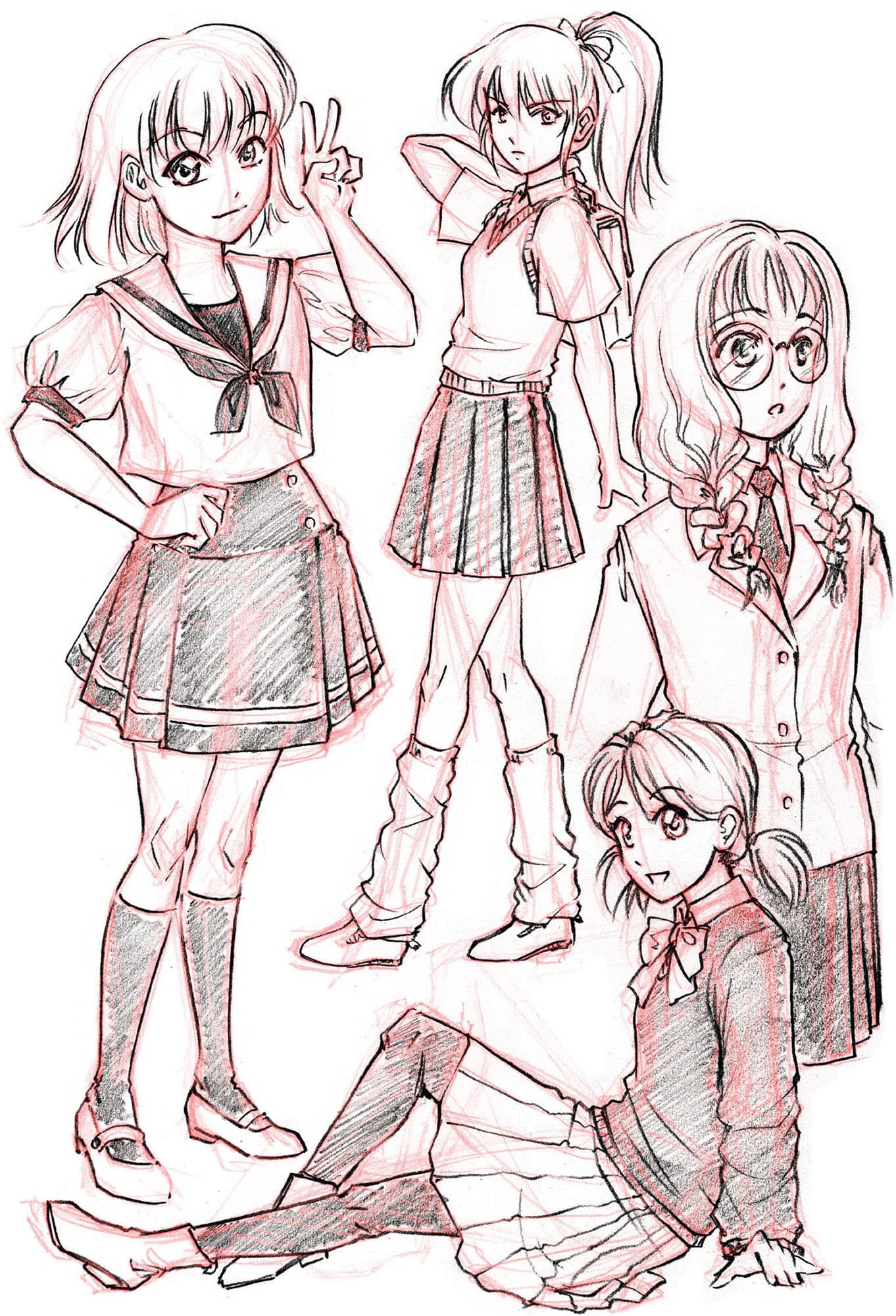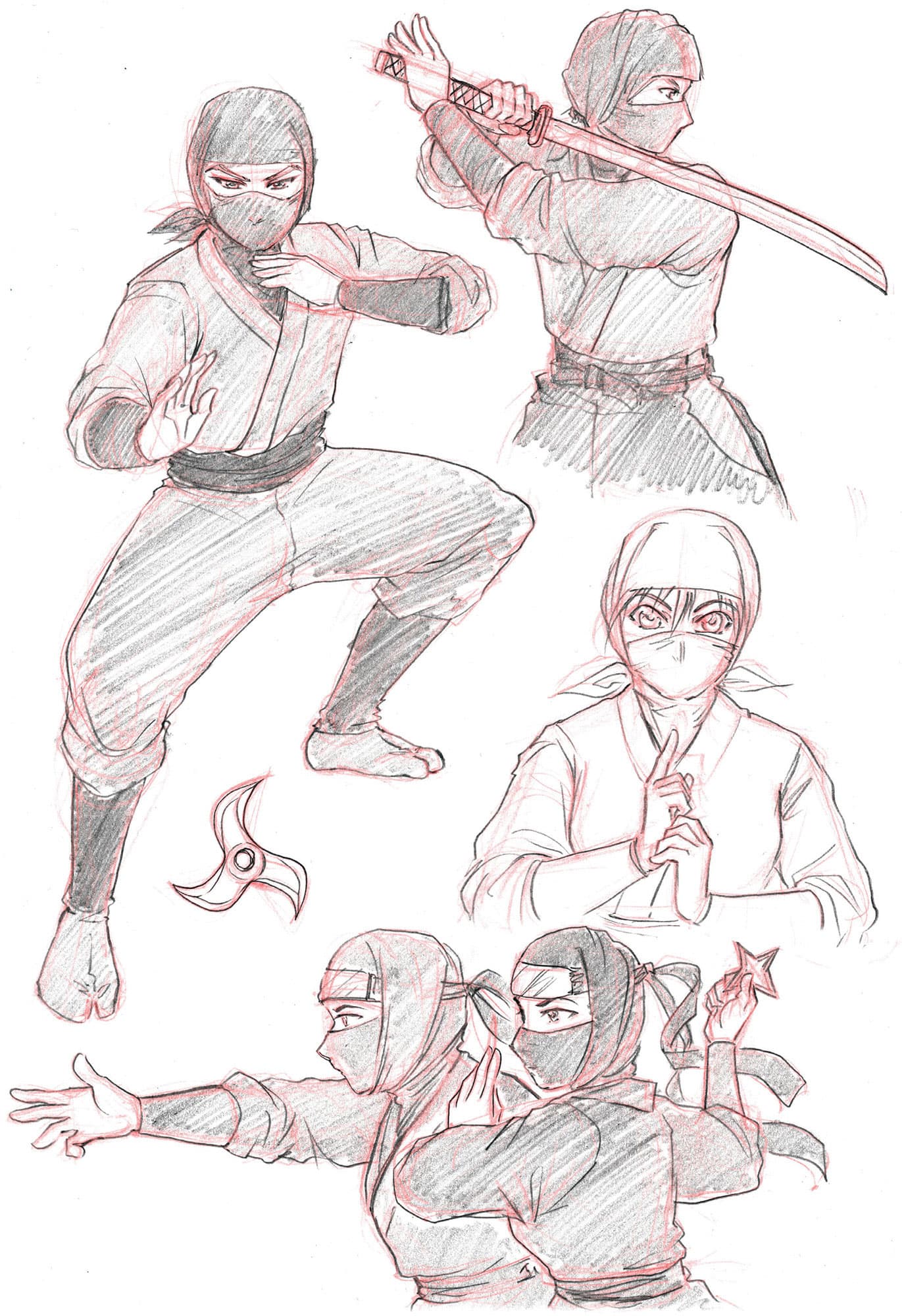SCHOOLGIRL
NOW LET’S USE THE SKILLS YOU’VE LEARNED OVER THE LAST FEW PAGES TO BEGIN DRAWING YOUR OWN MANGA CHARACTERS, STARTING WITH THE SCHOOLGIRL. FROM HORROR STORIES AND ACTION-PACKED THRILLERS TO ROMANCES, MANY MANGA COMICS ARE SET IN SCHOOLS, MAKING THE SCHOOLGIRL AN ICONIC HEROINE. HERE ARE SOME TIPS FOR DRAWING HER TRADEMARK OUTFIT.

Shirts: Consider the collar style and sleeve length, and whether the fabric gathers.
Bottoms: Most manga schoolgirls wear pleated skirts featuring decorations like stripes or patterns.
Neckties: These can be ties, ribbons, or scarves.

Tops: Vests and sweaters look more casual; blazers and waistcoats are more formal.
Socks: These can be any length and may feature stripes or emblems. Some schoolgirls wear tights instead.
CHARACTER SHOWCASE: ANGELA THE SCHOOLGIRL
A bubbly girl, Angela is well-liked by her classmates. She goes to an elite school with a distinctive uniform in navy and red. Her blazer looks sharp, and her socks match her tartan skirt.

SCHOOLBOY
JUST AS POPULAR AS THE SCHOOLGIRL, THE SCHOOLBOY IS OFTEN THE MAIN CHARACTER IN CONTEMPORARY MANGA SERIES. HIS UNIFORM WILL ALSO VARY ACCORDING TO THE SCHOOL HE ATTENDS AND HIS STYLE.

Tops: Waistcoats, sweaters and blazers can have Mandarin collars, trim, armbands, and/or pockets.
Neckties: Ties can be wide or slim. Some schoolboys may even wear bow ties or cravats.
Shirts: In addition to the collar style, consider whether the schoolboy would wear it open at the neck.
Bottoms: Shorts are popular during warm weather.
CHARACTER SHOWCASE: ADAM THE SCHOOLBOY
Adam goes to the same school as Angela (shown here), so his suit and tie have the same navy-and-red color scheme. His blazer is cut longer than the girls’ version, however, and he has a worried look on his face.

STEP-BY-STEP: SCHOOLGIRL & SCHOOLBOY
LET’S COMBINE THE CHARACTERS, FACIAL EXPRESSIONS, AND CLOTHES WE DISCUSSED SHOWN HERE AND DRAW A PORTRAIT OF THE SCHOOLGIRL AND SCHOOLBOY TOGETHER!

Roughly and lightly lay out your figures in pencil. Mark the main muscle groups and tricky elements, such as the hands.
I used pencil, fineliner pens, markers, and white gel pens on 200gsm cartridge paper.

Add details to your sketch, including facial features, hair, and clothing.

Go over your pencil lines with fineliner pen. Let the ink dry; then carefully erase your pencil marks without damaging the paper.

Color in the characters’ skin, softly fading out for subtle highlights.

Fill in the midtones on the darker, more matte areas, such as the blazers and ties. Layer darker shadows over the base colors and gradients.

For shiny surfaces, such as hair, follow the contours of the subjects and use more shading to increase contrast.

Use white ink to dot in small, shiny highlights and draw loose strands of hair over darker areas.

MAGICAL GIRL
Brave, beautiful, and bold, the Magical Girl is the ultimate manga heroine. Most of the time, she looks like a normal girl, but when someone needs help, she transforms into a sparkly superhero and saves the day!

Hair: Often elaborate and gravity-defying, the magical girl’s hair can be long and thick and come in all colors.
Outfit: Give her a strong silhouette with a balanced look of fitted sections and voluminous ruffles. Think pointed collars, poufy skirts, tight bodices, and flared jackets.

Accessories: The cuter, the better! Tiaras, ribbons, gloves, capes, bracelets, necklaces, chokers… decorate her to the max!
Gestures: To perform magical attacks, this character might use a magic wand, sword, bow and arrow, or even special hand gestures.
Motifs: The magical girl needs a strong motif related to her powers. Try butterflies, hearts, flowers, or stars. Repeat it throughout your character’s design.
CHARACTER SHOWCASE: ANGEL THE MAGICAL GIRL
When Angela the Schoolgirl (shown here) hears a cry for help, she transforms into Angel, defender of love and justice! Her hair turns pink and curly, and her outfit features hints of her school colors. She carries a heart-shaped wand with a jewel that matches her eyes so that she can defeat her enemies and change their ways through the power of love.

STEP-BY-STEP: MAGICAL GIRL
JUST LIKE TRADITIONAL ART MEDIA, SUCH AS COLORED PENCILS AND MARKERS, DIGITAL TOOLS CAN BE USED TO ADD COLOR TO YOUR MANGA ARTWORK.
I sketched my figure using mechanical pencil; then I scanned and colored it in digitally.

Use red pencil to lay down the main lines of the body. Focus on getting the proportions right and capturing the energy of the pose.

With rough lines, add details to the character’s face, clothing, hair, and wand. Change elements of the drawing now, such as leg positions, and add movement using flowing hair and ribbons.

With black pencil, go back over your red pencil lines to create the final outlines.

Photocopy and then scan your image. You can also scan the image and then adjust the color settings to remove the red lines.

I’ve included examples using two kinds of software. To prepare your image for digital grisaille coloring (shading in gray and then tinting with color), set this line-art layer to “multiply.” Then set it to “overlay” and add a layer underneath for colors, and another layer beneath it for shadow adjustment. Then add a layer at the bottom for shadows.

Set the color layer and shadow adjust layer to “clipping mask” or “clipping group” so that they affect only the shadow layer.

On the shadow layer, use a mid-gray fill. Shade gradually, using white shades for highlights and black ones for shadows.

Fill in the shadow adjustment layer with reddish-brown to tint the shadows to a sepia shade.

On the color layer, flat fill in the colors to tint the now-sepia shadows beneath. Switch the layer setting between “normal” and “overlay.”

Add a final layer on top to create special effects like glowing, highlights, and sparkles.

OFFICE WORKER
THE MAIN PROTAGONISTS OF MANGA AIMED AT OLDER AUDIENCES, OFFICE EMPLOYEES WILL WORK A TYPICAL 9-TO-5 DAY, BUT THEIR TIME MAY BE DEVOTED TO DEALING WITH NONTRADITIONAL WORK PROBLEMS SUCH AS ZOMBIE ATTACKS. LET’S GET YOUR OFFICE WORKER CORRECTLY SUITED TO HANDLE ANYTHING!

Suit collars: Draw a Mandarin, peak, notched, or shawl-style lapel.
Fastenings: Short jackets sometimes feature zippers, but most will have several buttons. Jackets can be single-breasted or double-breasted, or left open.

Accessories: Aside from neckties, consider pocket squares, waistcoats, and suspenders for men. Scarves, fancy belts, and brooches are popular among women.
CHARACTER SHOWCASES: ZOFIYA & MATHIEU
Zofiya is the stern finance director at a software firm, while Mathieu is the laid-back marketing guru called in to boost profits. They are polar opposites, but sparks fly as they face off in the boardroom!

STEP-BY-STEP: OFFICE WORKERS
NOW LET’S LEARN TO DRAW ZOFIYA AND MATHIEU IN A SCENE TOGETHER!

Using a pencil and paper, draw the main shapes of your characters. Be mindful of perspective, and use the figures’ hands to emphasize it.
I used colored pencils on 90gsm tracing paper for this project.

Fill in the details of the characters’ clothing, hair, and faces. Add framing touches to the design, such as scattered sheets of paper fluttering around.

Use darker shades of colored pencils on tracing paper to carefully trace your drawing. Avoid using black and gray if possible; instead; use browns for warm colors and dark blues for cool ones. This will create a more vibrant finish.

Begin shading the figures, starting with the darkest shadows in the outlines and leaving areas blank to create highlights and lighter shading. Use sharpened pencils to showcase strong, thin strokes on the figures’ hair.

Follow the contours of the figures with your strokes and layer shadows on top to add depth and contrast.

Fill in any remaining areas with your lightest shades, leaving the highlights white.

ELITE SOLDIER
ESSENTIAL CHARACTERS IN CONTEMPORARY ACTION MANGA, ELITE SOLDIERS CAN TAKE THE ROLE OF THE HERO OR SUPPORTING CHARACTER WHEN YOU NEED HEAVY FIREPOWER AND SOMEONE TO FIGHT THE BAD GUYS AND MONSTERS. THEY SHOULD LOOK CAPABLE, GRITTY, AND STRONG.

Insignia: Soldiers are part of specific units, and their uniforms might feature their coat of arms or insignia. Consider displaying one of these on their berets, arm patches, badges, or pins.
Storage: All soldiers need pockets, clips, and compartments to store their equipment within easy reach. They may also need extra holsters for their weapons or ammunition belts.
Combat uniform: Also called “army fatigues,” soldiers wear both fitted one-piece as well as two-piece, looser-fitting uniforms in hard-wearing fabrics that allow them full range of movement even in messy environments.
Protection: When on a mission, a soldier may wear extra padded body armor over the torso, elbow and knee guards, helmets, and goggles.
CHARACTER SHOWCASES: ROXANNE & LOGAN
Roxanne is a seasoned veteran and cold-weather specialist. Quiet and determined, she focuses entirely on her objectives. She helped train Logan (shown here), who has matured from a brash, young man into a cautious, reflective officer.


MARTIAL ARTIST
FOR A MODERN-DAY MANGA HERO OR HEROINE WHO CAN FIGHT, TRY CREATING A MARTIAL ARTIST. THERE ARE MANY STYLES OF MARTIAL ART AROUND THE WORLD, BUT WE’LL FOCUS ON THE ONES FROM JAPAN.

Hand-to-hand: Karate, judo, and aikido emphasize unarmed combat, and practitioners wear clothing that allows for free range of movement. The gi uniform consists of a wrap-style top worn with pants and a belt. Experienced practitioners wear long culottes or hakama.

Clothing: Practitioners generally wear hakama with wrap-style tops. To spar, practitioners wear full armor or bogu (training armor).
Swords: Kendo, iaido, and itto-ryu all involve Japanese swords. In practice, students use a slim, wooden bokken or a thick bamboo shinai. The iconic sword with the curved blade is called a katana.

Archery: Japanese archery is called kyudo. The bows are asymmetrical, tall, and traditionally made from bamboo. Practitioners can wear arm bands, breastplates, and gloves for protection.

Stealth arts: Ninjutsu is the fighting system of the Japanese shadow warrior, the ninja or shinobi. Traditionally war spies, their style is efficient, quiet, and resourceful, and they wear practical clothing to allow for movement and quick getaways. They use multiple weapons, most famously shuriken (a small concealed dagger) and throwing stars.
